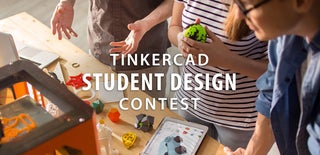Introduction: Motorized Nerf Gun
This is an entry for the Make It Move TinkerCad contest.
Wouldn't it be fun to make your own nerf gun? I am going to show you how in this Instructable!
This is my first instructable, so sorry for any mistakes.
Step 1: Create Your Nerf Ammo
To start off, you will need to know the dimensions of your ammunition, so you can model the gun around it.
I am using some cheap Dollar General nerf rounds, but you can use anything, even rival ammo!
Calipers are very useful in this step, and all the others.
my dimensions were:
Hight:14.25mm
Width:14.25mm
Length:68mm
Yours may vary.
Step 2: Model Your Electronics
I am using some electronics from an RC car that broke, so my motors have gears permanently affixed to them.
My battery I am using is also from that car,(the green box) and is rechargeable.
Your shapes do not have to be detailed, hence the green battery box:)
I am also using a basic endstop switch, because it is only on momentarily.
Step 3: Flywheels!
Here is where modeling the ammo comes in handy.Since the gun sucks the dart through, you want to have the correct curve on the flywheels, crush of the nerf bullet, and size of the wheels.
I did not size mine correctly, and had to add rubber bands around them, to give the crush wanted.(see photo) It did create vibration, so size them correctly in the first place. This might require some trial and error.
I am friction fitting them on the motors, which works OK.
Step 4: Creating the Body
Use the motors, battery, and switch as holes to create the body shape of the gun.
Do not forget to model in correctly sized holes and slots for wires!(I had to use a Dremel) This does not look like a gun, because the shape of the battery, and because I am still learning Tinkercad. Mine had to use a LOT of supports while printing:( so if you are going to print this, the goal is NO supports!
You could create a magazine for it, but that is not necessary.
Step 5: Putting It All Together
After printing the parts, you may need to sand them to make everything fit. I soldered on some standard breadboard wires as connectors, but you could use something different.
Step 6: Try It Out!
After charging the battery overnight, I plugged the cables together, and it worked flawlessly!
Since the motors aren't very fast, it only shot across the hallway, but think of what brushless motors would do!
Step 7: Improvements
You could add brushless motors to achieve Dart-Shredding Speed!
You could add a smaller/stronger battery to achieve, well, um, yeah!
You could add a better body shape, or handgrip.
You could add speed control to the motors
You could add a better battery connector and switch.
You could just be lazy and steal my design to print an exact copy!

Participated in the
Tinkercad Student Design Contest











